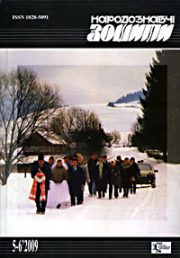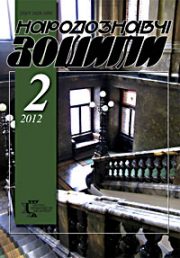The Ethnology Notebooks. 2025. № 5 (185), 1097—1104
UDK930:340.15(363:4/5-44)”653″(09)
THE DIPLOMACY OF THE LANGOBARDS AND AVARS IN 572/573—610
LAHODYCH Volodymyr
- ORCID ID: https://orcid.org/0000-0002-0677-4408
- PhD student, Faculty of History,
- Ivan Franko National University of Lviv,
- Assistant of the Department of Medieval and Byzantine History,
- Faculty of History, Ivan Franko National University of Lviv,
- 1, Universytetska Street, 79000, Lviv, Ukraine,
- Contacts: e-mail: lagodicvolodimir@gmail.com
Abstract. Introduction. With the migration of the latter to the north of the Danube after 557, the diplomatic system of the era underwent structural changes. The leading tendency of this process was the peculiarities of the society and economy of the Khaganate, which were «tied» to conducting permanent war campaigns. With the foreign policy activation of both the Langobards and Avars in the second half of the 6th century, the Roman Empire became their main opponent. In preparation for an invasion of its territory in 568, the Avar Khagan Bayan I (562—602) entered into an alliance with the Lombard monarch Alboin (566—572/573).
The enthronement of Aguilulf in Pavia marked a new stage in the relations between the Langobards and nomads. The actual manifestation of this was organized actions against the Romans in Dalmatia during 590—603. Nevertheless, in the 610s Avars moved away from the policy of rapprochement with the Langobards, making a series of raids on the territories of Friuli and Tuscany.
The article aims to analyze the evolution of diplomatic relations between the political entities of the Lombards during the interregnum (574/575—584) and the restoration of monarchical power with the enthronement of Authari (584—590) and Agilulf (590—615/616) in Pavia on one side, and the Avar Khaganate on the other, with a focus on identifying the role of Constantinople’s diplomacy in shaping these interactions.
The research methodology is based on the material of narrative sources of the era («History» of Menander the Protector’s, «History» of Theophylact Simocatta’s, «Ecclesiastical History» of John of Ephesus’, «History of the Langobards» Paul the Deacon’s), an attempt is made to reconstruct the context of relations between the political entities of the Lombards and the Avars in the period in question. Particular attention is paid to the role of Constantinople’s diplomacy as a catalyst for the beginning of the nomads’ campaigns against the Langobards.
Keywords: Middle Ages, Avars, Bayan, Langobards, Agi lulf, Constantinople.
Received 8.09.2025
REFERENCES
- Blockley, R. (Ed.). (1985). The History of Menander the Guardsman. Liverpool: Francis Cairns.
- (1836). History of the Franks by the Saint Gregory of Tours (Vol. 1). Paris: Jules Renouard [in French].
- Bury, J. (1928). The Invasion of Europe by the Barbarians. A series of lectures. London: Macmillan and Co. Limited.
- Smith, R. (1860). The Third Part of the Ecclesiastical History of John Bishop of Ephesus. Oxford: University Press.
- Foulke, W. (1907). History of the Langobards by Paul the Deacon. Philadelphia: University Press.
- Whitby, M., & Whitby, M. (Ed.). (1986). The History of Theophylact Simocatta. Oxford: University Press.
- Riemenschneider, J. (2024). Procopius and the social cosmos of historiography. Digressions, discourses and Roman society in Late Antiquity. Boston; Leiden: Brill [in German].
- Zhdanovych, O. (2021). The Byzantine Empire and the barbarians the work of Menander Protector. Doctoral dissertation. Taras Shevchenko National University of Kyiv [in Ukrainian].
- Whitby, M. (1988). The emperor Maurice and his historian: Theophylact Simocatta on Persian and Balkan Warfare. Oxford: Clarendon Press.
- Edictum, Rothari. (1869). In: MGH Fontes (Iuris 2, pp. 1—73). Hanover: Weidmannos [in Latin].
- (1878). Origin of the tribe of the Langobards. In: MGH SS rer. (Lang 1, pp. 1—6). Hanover: Weidmannos [in Latin].
- Abel, O. (1888). The Chronicle of Fredegar and the kings of the Franks, the biographies of Abbot Columban, Bishops Arnulf, Leodegar and Eligius, Queen Balthilde. Leipzig: Verlag der Dyk’schen Bechhandlung [in German].
- Pohl, W. (2018). The Avars. A Steppe Empire in Central Europe (Pp. 567—822). Itacha and London: Cornwell University Press.
- Pavliuk, A. (2014). Diplomatic Relations between Franks and Langobards during the «Reconquista of Byzantine» in Italy (584—590). Bulletin of the Precarpathian University. Series «History» (Issue 25, pp. 177—182) [in Ukrainian].
- Pavliuk, A. (2013). The Character of the Langobard Conquest of Italy (568—584). The scientific, cultural and educational local history journal «Halychyna», 22—23, 115—121 [in Ukrainian].
- Kaldellis, A., & Kruse, M. (2023). The Field Armies of the East Roman Empire (361—630). Cambridge: University Press.
- Stein, E. (1919). Studies on the history of the Byzantine Empire, especially under the emperors Justinus II and Tiberius Constantinus. Stuttgart: J.B. Metzlersche Verlagsbuchhandlung [in German].
- Lahodych, V. (2025). Embassy of Spatharius Narses to the Lombards in 581. Proceedings of the LAUREA VІ. The Ancient World and the Middle Ages: Scientific readings in memory of Professor Volodymyr Ivanovych Kadeev. Kharkiv [in Ukrainian].
- Lahodych, V. (2024). The circumstances of concluding and the provisions of the 568 Agreement between the Langobars and Avars. Ethnic History of European Nations, (Issue 72, pp. 7—12) [in Ukrainian]. DOI: https://doi.org/10.17721/2518 1270.2024.72.01
- Whitby, M., & Whitby, M. (Ed.) (2007). Chronicon Paschale 284—628 AD. Liverpool: University Press.
- Mango, C., & Scott, R. (Ed.). (1997). The Chronicle Of Theophanes Confessor. Byzantine and Near Eastern History AD 284—813. Oxford: Clarendon Press.







